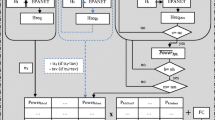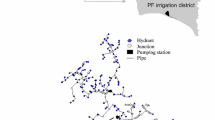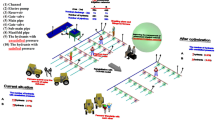Abstract
Rotation scheduling implies a reduction in pipe flows and, consequently, in network cost. This kind of scheduling is considered rigid, but the recent development of new technologies, such as Supervisory Control And Data Acquisition systems (SCADA), has allowed high-frequency irrigation (1 day or less), making it an interesting option when either designing or managing an irrigation network. In this paper, simple formulas and relevant variables are presented to easily assess the relative flow reduction in networks under a rotation schedule. The flow reduction depends on the number of outlets supplied and the probability of these being opened. The presented equations were applied to different networks, and the results obtained were accurate, with an average error of only 5%. It was observed that the ratio between relative cost reduction and the relative flow reduction had a mean value of 0.50. This ratio might be used to roughly estimate the cost reduction from the calculated relative flow reduction. The flexibility of the networks under a rotation schedule was improved by adding just one outlet flow rate to those used to size the pipes.






Similar content being viewed by others
Data Availability
All the data used for this study can be provided by the authors upon request.
References
Alduan A, Monserrat J (2009) “Estudio comparativo entre la organización a la demanda o por turnos en redes de riego a presión” (Spanish). Ingeniería del agua 16(3)
Aliod R, González C (2007) A computer model for pipe flow irrigation problems. In: Numerical modelling of hydrodynamics for water resources. Proceedings of the conference on numerical modelling of hydrodynamic systems (Zaragoza, Spain, 18-21 June 2007). CRC Press, p 293
Bonnal C (1963) “Manuel d'irrigation collective par aspersión” (French). OCDE, París
Clemens AJ (1986) Canal capacities for demand under surface irrigation. J Irrig Drain Eng 112(4):331–347. https://doi.org/10.1061/(ASCE)0733-9437(1986)112:4(331)
Clément R (1966) “Calcul des débits dans les réseaux d’irrigation fonctionnant à la demande” (French). La Houille Blanche 5:553–575
CTGREF (Centre Technique du Génie Rural des Eaux et des Forets) (1974) “Lois de probabilité de débits de pointe d’un réseau d’irrigation collectif par aspersion. Loi de Clément. Verification a partir d’enregistrements” (French). Note Technique 2. Aix- en-Provence (France)
Farmani R, Abadia R, Savic D (2007) Optimum design and management of pressurized branched irrigation networks. J Irrig Drain Eng 133(6). https://doi.org/10.1061/(ASCE)0733-9437(2007)133:6(528)
García Asín S, Ruiz CR, Aliod R, Paño J, Seral P, Faci E (2011). Nueva herramientas implementada en Gestar2010 para el dimensionado de tuberías principales en redes de distribución en parcela y redes de distribución general a turnos. In Actas del XXIX Congreso Nacional de Riegos Córdoba. (Spanish)
Jimenez-Bello MA, Martinez Alzamora F, Bou Soler V (2010) Methodology for grouping intakes of pressurized irrigation networks into sectors to minimize energy consumption. Biosyst Eng 105(4):429–438. https://doi.org/10.1016/j.biosystemseng.2009.12.014
Lamaddalena N, Sagardoy JA (2000) Performance analysis of on-demand pressurized irrigation systems. Irrigation and drainage paper, 59. FAO, Rome
Lapo CM, Pérez-García R, Izquierdo J, Ayala-Cabrera D (2017) Hybrid optimization proposal for the design of collective on-rotation operating irrigation networks. Procedia Engineering 186:530–536. https://doi.org/10.1016/j.proeng.2017.03.266
Monserrat J (2009) Allocation of flow to plots in pressurized irrigation distribution networks: analysis of the Clément and Galand method and a new proposal. J Irrig Drain Eng 135(1):1–6. https://doi.org/10.1061/(ASCE)0733-9437(2009)135:1(1)
Monserrat J, Poch R, Colomer MA, Mora F (2004) Analysis of Clément’s first equation for irrigation distribution networks. J Irrig Drain Eng 130(2):99–105. https://doi.org/10.1061/(ASCE)0733-9437(2004)130:2(99)
Moreno MA, Córcoles JI, Tarjuelo JM, Ortega JF (2010) Energy efficiency of pressurized irrigation networks managed on-demand and under a rotation schedule. Biosyst Eng 107(4):349–363. https://doi.org/10.1016/j.biosystemseng.2010.09.009
Rodríguez Díaz JA, López LR, Carrillo Cobo MT (2009) Exploring energy saving scenarios for on-demand pressurized irrigation networks. Biosyst Eng 104(4):552–561. https://doi.org/10.1016/j.biosystemseng.2009.09.001
Funding
This research was partially funded by “Infraestructures.cat”.
Author information
Authors and Affiliations
Contributions
Conceptualization: Monserrat, J.; Results: Alduan, A., Monserrat, J.; Writing and editing: Monserrat, J., Alduan, A.
Corresponding author
Ethics declarations
Conflict of Interest
None.
Additional information
Publisher’s Note
Springer Nature remains neutral with regard to jurisdictional claims in published maps and institutional affiliations.
Glossary
- ()w
-
means to round down.
- Ab
-
is the optimum on-farm irrigation block (ha).
- Ap
-
is the size of the farm (ha).
- d
-
is the flow rate of an outlet (l s−1).
- N
-
is the number of farms supplied.
- nb
-
is the number of on-farm irrigation blocks.
- nb max
-
is the maximum number of on-farm irrigation blocks.
- npr
-
is the number of farms under a rotation schedule.
- p
-
is the probability of an outlet being opened.
- q
-
is the probability of an outlet being closed.
- Qd
-
is the flow for on-demand networks (l s−1).
- Qr
-
is the flow for networks under a rotation schedule (l s−1).
- qrg
-
is the flow rate of the on-farm irrigation system (l s−1 ha −1).
- qsg
-
is the water requirements of the crops (l s−1 ha −1).
- rop
-
is the operation index.
- ton
-
is the time the network is working a day (h).
Rights and permissions
About this article
Cite this article
Monserrat, J., Alduan, A. Cost Reduction in Pressurized Irrigation Networks under a Rotation Schedule. Water Resour Manage 34, 3279–3290 (2020). https://doi.org/10.1007/s11269-020-02612-6
Received:
Accepted:
Published:
Issue Date:
DOI: https://doi.org/10.1007/s11269-020-02612-6




